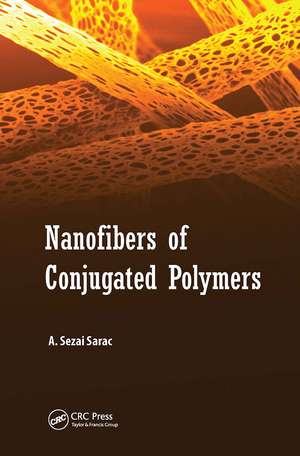Nanofibers of Conjugated Polymers
Autor A. Sezai Saracen Limba Engleză Hardback – 9 iun 2016
Electrospinning is a versatile technique that is used to produce ultrathin continuous fibers with high surface-to-volume and aspect ratios from a variety of materials, including polymers, composites, and ceramics. Conductive materials in fibrillar shape may be advantageous compared with films because of their inherent properties such as anisotropy, high surface area, and mechanical strength. They are of particular interest in electroactive composites as they can be efficiently distributed in an insulating polymer matrix to improve both electrical and mechanical properties. Combination of electrical properties with good mechanical performance is of particular interest in electroactive polymer technology.
This book covers the general aspects of electrospinning and discusses the fundamental concepts that can be used to produce nanofibers with the help of mathematical models and equations. It also details the methods through which different polymeric structures can be included in conjugated polymers during electrospinning to form composites or blends of conjugated polymer nanofibers.
Preț: 627.06 lei
Preț vechi: 840.19 lei
-25% Nou
Puncte Express: 941
Preț estimativ în valută:
120.04€ • 123.46$ • 99.59£
120.04€ • 123.46$ • 99.59£
Carte tipărită la comandă
Livrare economică 17 februarie-03 martie
Preluare comenzi: 021 569.72.76
Specificații
ISBN-13: 9789814613514
ISBN-10: 9814613517
Pagini: 296
Ilustrații: 157
Dimensiuni: 152 x 229 mm
Greutate: 0.57 kg
Ediția:1
Editura: Jenny Stanford Publishing
Colecția Jenny Stanford Publishing
ISBN-10: 9814613517
Pagini: 296
Ilustrații: 157
Dimensiuni: 152 x 229 mm
Greutate: 0.57 kg
Ediția:1
Editura: Jenny Stanford Publishing
Colecția Jenny Stanford Publishing
Public țintă
Academic and PostgraduateCuprins
Polymeric nanofibers; electrospinning and polymer processing parameters. Theoretical consideration of electrospinning. Mathematical models and equations. Application of nanofibers. Conjugated polymers. Supercapacitors. Synthesis of conjugated polymers such as PPy and PEDOT. Polyaniline composite nanofibers and their applications. Examples of electrochemical impedance and spectroscopic measurements on conjugated polymeric composite or blend nanofibers.
Notă biografică
A. Sezai Saraç is professor at the Department of Chemistry and Polymer Science & Technology, Istanbul Technical University (ITU), Turkey. He received his B.Sc. and M.Sc. in chemical engineering from ITU and his Ph.D. in chemistry from the University of Missouri-Rolla, USA. He was awarded a doctor honoris causa in chemical sciences by the Tajikistan Academy of Sciences in 2011. Prof. Saraç has authored about 200 scientific publications, 8 review articles and book chapters, and nearly 170 conference contributions. He has received several fellowships and grants and has played a key role in various international and national projects. His recent research interests are focused on thin conjugated polymeric nanofibers and their nanocomposites, modified carbon fibers, biosensor microelectrodes, electrocopolymerization, and their surface characterizations.
Descriere
This book covers the general aspects of electrospinning and discusses the fundamental concepts that can be used to produce nanofibers with the help of mathematical models and equations. It also details the methods through which different polymeric structures can be included in conjugated polymers during electrospinning to form composites or blends of conjugated polymer nanofibers.
